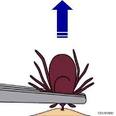You’ve heard it all before, but I want to say it again: don’t mess with the tiny tick.
Ticks and tick-borne diseases are found all over the world. Don’t fool yourself: disease-carrying ticks have been found not just in northeastern United States (hotspot for one tick-borne disease, Lyme), but all over Canada and the United States, including the southeastern US, and Australia, Europe, northern Asia, Latin America, and some parts of Africa.
Bite prevention, early detection and removal (together) are the key. Ticks transmit their explosive diseases within or just after 24 hours after biting. There are over 300 different pathogens with which the various species of tick can infect a human, causing sometimes life-long, life-altering, chronic, and painful consequences. The symptoms of some of these diseases (such as Lyme disease, Babesiosis, Anaplasmosis, Rocky Mountain spotted fever, Ehrlichiosis, and Tularemia) are frequently confused as being symptoms of other diseases, such as MS, fibromyalgia, Chronic Fatigue Syndrome, rheumatoid arthritis, or lupus, to name a few. Not fun! Be aware!
I know several people who are suffering or have suffered tick-borne diseases, one a little kid who is still struggling with the debilitating pain of vicious diseases transmitted to him from a single tick bite in 2006, 6 years ago. Back then, I had never even heard of tick-borne diseases. He did not receive the treatment he needed right away and the symptoms became chronic. Where he lives in the Okanagan valley of British Columbia, Canada, there are few doctors who are educated in the types of diseases he has. He and his family have to travel over 6 hours to a doctor in Seattle for treatment. The drugs he must take daily sometimes cost over $800 out-of-pocket a month. Sometimes he is in so much pain, the normally active kid can barely move.
If you’re anything like me, witnessing this and understanding the danger just makes you want to panic and lock yourself inside with cans of DEET, but, really, we can accept and respect this danger just like we have accepted bears and skin cancer. We must intelligently prepare ourselves and our families to be aware and to be ready to prevent and deal with it.
What ticks look like:
| Black-legged ticks, male and female nymph and adult stages. From wac.450f.edgecastcdn.net |
There are two stages in which a tick is dangerous to humans, the tiny nymph stage and the adult stage. In the nymph stage, they look like freckles that move, or like poppy seeds. In the adult stage they are easier to spot.
Other links to help with tick ID:
Pictures of common North American ticks and their geographic distribution in the US (these pictures also apply to Canada, because, as far as I know, ticks don’t need passports to cross the border).
A thorough description of ticks found in North America and the more common diseases they are known to transmit.
| Black-legged ticks, various stages of growth. From lymedisease.org |
Really, it doesn’t matter if you can correctly identify the species of tick. Although some believe that only the black-legged (deer) tick and western black-legged tick should be tested, I believe that regardless of the type of tick, you should deal with them the same way… all species can carry diseases.
How to avoid tick bites:
- Let’s all say it together: PREVENTION IS BETTER THAN CURE!
- Avoid leaf-litter, tall grass, logs, stumps and bushes. They like nice, moist spots. They can’t fly. Stay in the middle of trails! Where there are animals like deer and mice, there are usually ticks. Ticks are most active from April to October in North America, especially after mild winters. Watch this video to see how ticks get on you by brushing against shrubs and long grasses.
- Wear long-sleeved shirts and long pants. Tuck pants into socks (yeah…). Don’t wear sandals. Ticks usually are brushed onto your legs and then tend to climb up. Spray 30%+ DEET product on clothing or treat clothing with permethrin, especially shoes, socks and lower pant legs (good for about 6 washes). Just don’t get DEET or permethrin in your mouth, eyes, hands, etc! Some outdoors clothing can be bought pre-treated with permethrin, good up to 70 washes. Natural repellents apparently don’t work.
- To make detection easier, wear light-coloured clothing. Check and remove clothing carefully. Place clothes in a pile on a hard surface and ticks should make their way to the top of the pile. Putting clothing in a dryer on high heat for about half an hour should kill ticks.
- Check yourself every day with a small mirror and a fine-toothed comb. This is probably the most important step for yourself, your kids and your pets. Check especially your hair, armpits, groin, ears, belly button, toes and backs of knees – all the nooks and crannies. It might seem like a pain, but trust me – I’ve seen what suffering from tick-borne diseases looks like. THAT is pain. Shower as soon as you can to wash off unattached ticks.
- Tick-proof your yard, especially if you live near woods. Click here and here for suggestions.
- Talk to your vet about protecting your pets.
What to do if you find an attached tick on your body:
 |
| Less than 50% of those infected remember having a tick bite or a classic bullseye rash. However, if you DO have bullseye rash, see a doctor IMMEDIATELY! From knowlyme.com |
- Remove tick safely with fine-tip tweezers (the kind with pointy ends). Grab the tick’s head as close to your skin as possible and slowly and steadily pull (do not twist). The first time I had to do this, I was surprised about how tenacious the little guy was. It took a bit more time than I expected. Be sure to remove any bits left behind with the tweezers. There are also nifty tick-removal tools, such as the Pro Tick Removal System, which we carry in our outdoors first-aid kit. Wash hands and disinfect bite site and tweezers (like with an alcohol pad). Photograph the tick for your own records.
- Test tick. Place tick in a plastic zip bag with a lightly-moistened paper towel. Some Canadian testing labs ask for a small, rigid plastic container, like a ilm canister. Label the bag with your name, date, site of bite and how long tick was attached.
- Send the tick away for testing. Friends who have struggled with tick-borne diseases tell me that some testing facilities are better than others. One that is recommended is IGeneX labs. There is also a Canadian testing protocol found here. Most people just have the tick identified and tested by a lab, health department or veterinarian. Sometimes the fees can be upwards of $35, but it is worth it.
- Watch for symptoms, such as a rash (especially a bulls-eye rash, but this only occurs in less than 70% of victims of Lyme disease; some of the other diseases can also cause rashes), fever, fatigue, headache, dizziness, mental confusion and “fogginess”, swollen lymph nodes, muscle and joint pain, numbness and tingling, and chills. Write down any symptoms and photograph any rashes. Typically the symptoms show up around 2 to 30 days after the tick has helped itself to your blood.
- If you think you might have contracted something, contact your doctor right away. Not all doctors are tick-borne disease savvy, especially in Canada, and some of the diseases are difficult to test for and diagnose, but early accurate testing, diagnosis and treatment are essential to prevent chronic problems. Some believe that regardless of symptoms, some, especially children in higher-risk areas, should be given pre-emptive, preventative treatment. Common diseases carried by ticks in North America include not only Lyme disease, but Babesiosis, Anaplasmosis, Rocky Mountain spotted fever, Ehrlichiosis, and Tularemia, all of which may need specific treatment. Typically, people are given a 6-week treatment of the oral antibiotic doxycycline or something similar for Lyme disease, but this does not treat the other diseases. I’ve been told by the experienced that having the tick tested and recording all symptoms helps for a more accurate diagnosis.
For more specific information about the various tick-borne diseases:
American Lyme Disease Foundation
California Lyme Disease Association (easy-to-read chart of diseases and symptoms, but not as thorough as the other two links)
A place to start to look for a tick-borne-disease-educated doctor (aside from asking your own doctor) may be: http://knowlyme.wordpress.com/doctors/ or http://www.lymedisease.org/resources/referrals.html
Further info:
Two of the best, general, easy-to-navigate sites about ticks and tick-borne disease:
- http://tbdalliance.org/
- http://www.lymedisease.org
Informative list of links related to ticks for those who really want to dig: http://www.nlm.nih.gov/medlineplus/tickbites.html).
Great little succinct PDF pamphlet about ticks and tick-borne disease prevention: http://www.mass.gov/eohhs/docs/dph/cdc/lyme/prevent-disease.pdf
Excellent CBC (Canadian) article about tick-borne diseases: http://www.cbc.ca/news/health/story/2009/06/04/f-lyme-disease-ticks.html
Naomi Osborn, The Outdoor Adventure team
 The Outdoor Adventure Giving you tips, tricks & recommendations to help make adventuring in the Outdoors fun, safe & exciting for you and your kids.
The Outdoor Adventure Giving you tips, tricks & recommendations to help make adventuring in the Outdoors fun, safe & exciting for you and your kids.





